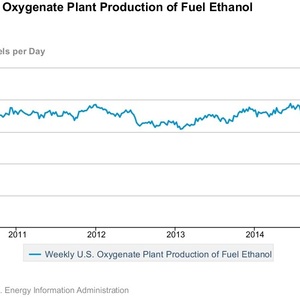EIA revises short-term ethanol production forecast

U.S. Energy Information Administration
May 14, 2015
BY Erin Krueger
The U.S. Energy Information Administration has released the May edition of its Short-Term Energy Outlook, slightly revising its ethanol production forecasts for this year, but maintaining the forecast for 2016 production made in April.
The EIA now predicts ethanol production will average 936,000 barrels per day this year, up from 935,000 barrels per day last year. In its April STEO, the EIA predicted ethanol production would average 944,000 barrels per day this year.
Advertisement
In December, ethanol production topped 1 million barrels per day for the first time, dropping to an estimated 927,000 barrels per day in April. Next year, the EIA predicts ethanol production will average 937,000 barrels per day.
Biodiesel production averaged 81,000 barrels per day last year, and is expected to be maintained at an average of 81,000 barrels per day this year. In 2016, biodiesel production is expected to increase to an average of 84,000 barrels per day.
Advertisement
According to the EPA, monthly average regular gasoline retail prices in April were almost unchanged from March at $2.47 per gallon. Weekly regular gasoline prices reached an average of $2.69 per gallon on May 11, reflecting rising crude prices and several outages at West Coast refineries. EIA expects retail gas prices to average $2.43 per gallon this year, down from $3.36 per gallon last year. In 2016, prices are expected to increase to $2.63 per gallon.
The EIA’s most recent weekly ethanol production statistics indicate production averaged 912,000 barrels per day the week of May 8, up from 887,000 barrels per day the prior week. The most recent monthly export data shows that more than 2.03 million barrels of ethanol were exported in February, with Brazil, India, Canada as the top three export markets. The U.S. imported only 39,000 barrels of ethanol in February, primarily from Brazil and Canada.
Related Stories
CoBank’s latest quarterly research report, released July 10, highlights current uncertainty around the implementation of three biofuel policies, RFS RVOs, small refinery exemptions (SREs) and the 45Z clean fuels production tax credit.
The U.S. Energy Information Administration maintained its forecast for 2025 and 2026 biodiesel, renewable diesel and sustainable aviation fuel (SAF) production in its latest Short-Term Energy Outlook, released July 8.
XCF Global Inc. on July 10 shared its strategic plan to invest close to $1 billion in developing a network of SAF production facilities, expanding its U.S. footprint, and advancing its international growth strategy.
U.S. fuel ethanol capacity fell slightly in April, while biodiesel and renewable diesel capacity held steady, according to data released by the U.S. EIA on June 30. Feedstock consumption was down when compared to the previous month.
XCF Global Inc. on July 8 provided a production update on its flagship New Rise Reno facility, underscoring that the plant has successfully produced SAF, renewable diesel, and renewable naphtha during its initial ramp-up.
Upcoming Events










